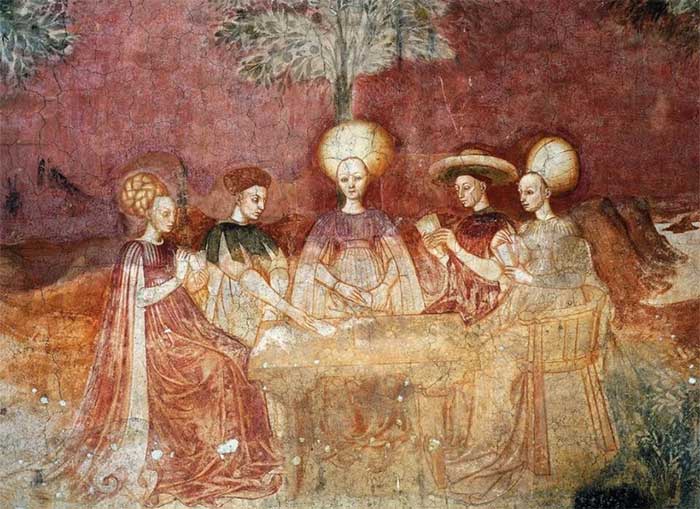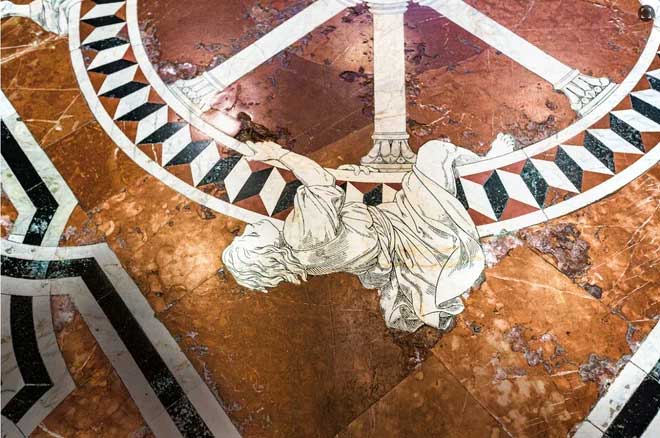Featuring mysterious imagery, such as the Hanged Man or Hierophant, tarot cards have inspired fantastical stories about their origins. Today, closely associated with fortune-telling, tarot is often believed to have originated in East Asia.
Researchers now believe that the rules of tarot card games did not originate in China or India, but in Renaissance Italy. Initially a card game for the Italian elite, the use of tarot cards for divination came much later.
Throughout its long process of “evolution,” tarot has maintained a “constant” – its adaptability. As Helen Farley writes in “A Cultural History of Tarot,” “tarot has evolved and adapted within the cultural currents of different eras.”

Image of card players in the fresco at Palazzo Borromeo in Milan, painted in 1450 – around the time when tarocchi first emerged (tarocchi was later referred to as tarot by French speakers). (Source: National Geographic).
The original use of tarot reflected a critique of the power of the Catholic Church. Then, in the early 19th century, the cards marked a shift from rationalism to mysticism. This role resonated during the tumultuous times of the Spanish Flu pandemic (1918-1919) and the two World Wars.
The Triumph of the Cards
Although tarot is a European invention, the card games from which it originated were invented in China, later spreading westward to the Arab and Islamic worlds. Arriving in Italy in the 1300s, possibly from Egypt, card games quickly became popular across all social classes in Europe.
A surviving deck from Egypt, found at the Topkapi Palace in Istanbul, labeled its royal cards as kings but did not represent human figures.
In contrast, the earliest European decks featured human images: fishmongers or clergy, alongside kings, queens, and other familiar figures in modern decks.
By the 1370s, shortly after its arrival in Europe, card games began to face opposition from the church. Attempts were made to ban the game, deeming it a frivolous gambling activity. Archives from cities record efforts to prohibit card games in Florence and Paris in the 1370s, and in Barcelona and Valencia in the 1380s.
In fact, the prohibition of card playing was difficult to enforce, and card games continued to thrive regardless. Such games were particularly popular among the nobility, who possessed intricately hand-painted decks stored in beautifully decorated boxes.
The first clue to the emergence of tarot is found in a letter dated 1449 – from a Venetian army captain to Queen Isabella of Naples, in which he gifted her a special deck of cards. The letter mentions that a young prince of Milan, Duke Filippo Maria Visconti, had conceived the game 30 years earlier.
According to the letter, Visconti commissioned renowned artist Michelino da Besozzo to paint the cards “with the utmost skill and exquisite decoration.”

Francesco Fibbia with some of his cards. (Source: Alamy/National Geographic)
The deck did not survive through the centuries, but it is believed to have included 16 classical deities, divided into four categories: Virtue, Wealth, Chastity, and Pleasure. For instance, Venus belongs to the category of Pleasure, while Apollo is categorized under Virtue.
Historians believe that the description in the letter marks a transitional phase between the standard Renaissance deck and the development of the tarot deck we know today.
Other decks that formed throughout the history of tarot include the Visconti-Sforza deck, commissioned by Visconti’s son-in-law, Francesco Sforza.
In the 1440s, another deck emerged in the Italian city of Bologna, developed by nobleman Francesco Fibbia. This 62-card deck was used to play a game called “tarocchi” – a game that, as it spread across Europe, became known as “tarot” in French.
On the Cards
The popularity of tarot during the Renaissance was likely not coincidental.
As author Farley noted, the Renaissance was characterized by “the joy of earthly pleasures and an increasing awareness of independence and self-expression.”
Amidst the splendor of art, Renaissance Italy was also ravaged by war, while the ostentation of the church’s luxury and wealth provoked disdain.
The designs of tarot cards mirrored this chaos. The Visconti-Sforza deck reflected the prevalence of corruption within the church and the proximity to violent and sudden death. One of the images in the deck is a skeleton holding a bow and arrow.
Despite such violent imagery, for 200 years, tarot remained a game. Then, at the end of the 18th century in France, it underwent a transformation. In response to the rationalism revered during the Enlightenment, mysticism became more popular.
After Napoleon’s campaign in Egypt in the late 1700s, this mysticism was fueled by a fascination with all things Egyptian.
Spiritualizing Tarot
The common assumption that tarot is an artifact of ancient wisdom is largely the work of 19th-century French writers, particularly Antoine Court de Gébelin, who was captivated by “Egyptomania” – a term that refers to ancient Egypt in the Western imagination.
He hypothesized that tarot originated from an ancient Egyptian priest who used the “Book of Thoth” to conceal their secrets in a game to ensure their survival.

A familiar image from tarot cards, the Wheel of Fortune, depicted on the floor of Siena Cathedral in Italy from the 14th to 16th century. (Source: Alamy/National Geographic).
Across the English Channel, members of the mystical order Golden Dawn reworked the tarot deck. Mystic Arthur Edward Waite and artist Pamela Colman Smith created the Waite-Smith deck in the early 1900s, linking it to mysteries surrounding the Holy Grail, medieval stories centered around the vessel used by Jesus at the Last Supper – the final meal Jesus shared with his disciples before being betrayed and arrested.
In the years following World War I, many Europeans and North Americans regained interest in spiritualism to reconnect with lost loved ones during the war. As a divination tool, tarot became popular once again.
American poet T.S. Eliot used tarot cards in his 1922 poem, “The Waste Land” – a chronicle of spiritual devastation post-war.
Modern Revival
In the 1970s, the New Age movement emerged as a peace force amidst the chaos and tension of the Cold War.
Once again, the role of tarot changed to reflect the era. The previous divinatory and spiritual functions of tarot were transformed into a self-healing function.
In recent years, tarot has once again become a cultural trend, indicating a new demand for spiritual wisdom. As the need for mental health support increases, many are turning to this game.
The standard 78-card deck is viewed by players as a tool to enhance emotional awareness during a time of global anxiety. Tarot decks feature countless popular themes, reflecting an enduring desire for imagery that is both relatable and escapist.
In the chaos and wars of the Renaissance, the earliest tarot users also found similar comfort.


















































